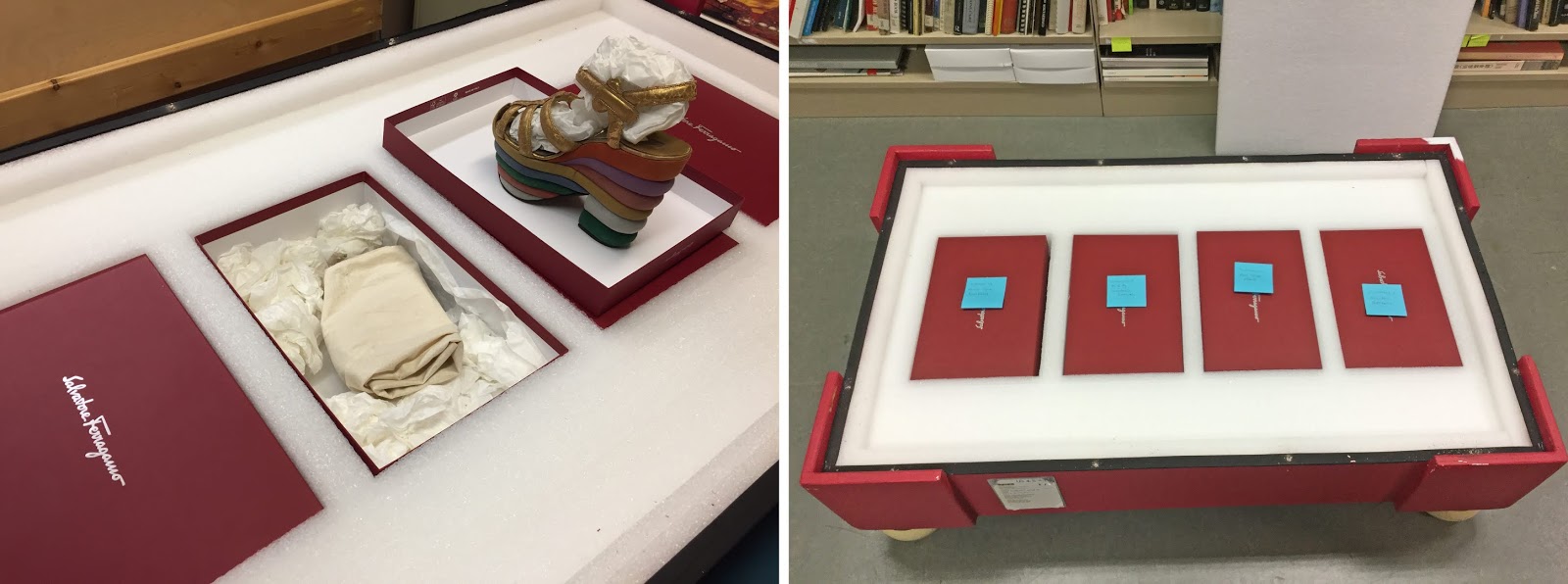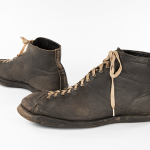It is a topic that you do not hear about in the public sphere, but one that museums around the world invest in each time they move art objects for the purposes of sharing with other museums. Let me walk you through the process; it is behind-the-scenes work that you might not have imagined.
At the Bata Shoe Museum, we bring art objects to Toronto to enrich our exhibition presentations. One of our current exhibitions, Want: Desire, Design and Depression Era Footwear, is filled with amazing 1930s art objects from our own collection. However, we wanted to make this exhibition incredible for our visitors, so we supplemented our own collection with some additional pieces from other Collections across the globe. Our lenders included the Museo Salvatore Ferragamo in Florence, Italy, who are holders of the ‘Rainbow Platform’ that Mr. Ferragamo designed in the 1930s. This incredible platform sandal has been called the ‘Mona Lisa’ of shoes!
 The ‘Rainbow Platform’ on very at the Bata Shoe Museum. © 2020 Museo Salvatore Ferragamo, Florence. All Rights Reserved.
The ‘Rainbow Platform’ on very at the Bata Shoe Museum. © 2020 Museo Salvatore Ferragamo, Florence. All Rights Reserved.
This small, single shoe is an irreplaceable object and an important part of the Museo Ferragamo’s collection. For them to agree to lend it to us, we had to show them that our museum had excellent air quality, stable humidity and temperature, low-level museum-quality lighting, and a secure building. In addition, the transport was specified as ‘fine art transport’. This high-quality shipping protocol ensures a safe and careful environment for the artefacts throughout the entire journey.
Fine art shipping involves custom crating by professionally trained art handlers and dedicated security personnel at every step. And yes! This process takes months of planning! The first step is to review customs regulations in both the origin and the destination countries. For the Italian transport from the Ferragamo Museum, an ATA Carnet was used which is a pre-clearance document that has the strictest use regulations. The Carnet was supplemented with a ProForma Invoice (where details of the items such as the genus and species of organic materials must be included) and a statement of permissions by the appropriate Italian Ministry. These documents generally take three months to produce once the applications are submitted. Customs brokers are hired and alerted at key developments. Insurance policies are reviewed at this stage as well. Once the paperwork has been done, the flights are booked. Not all airlines will carry fine art shipments.
 © 2020 Bata Shoe Museum, Toronto, Canada. All Rights Reserved.
© 2020 Bata Shoe Museum, Toronto, Canada. All Rights Reserved.
As the flight date approaches, the art objects are placed into the custom designed and built crate. Here the art objects are expertly placed in its shipping position with much attention paid to full, cushioned supporting and protection from any movement during shipping. Only stable, museum-quality materials are used in packing, ensuring only inert materials come in direct contact with the art object. After sealing the crate, coded transport labels are placed, and it is gently moved into the transport truck where it is strapped into place. The truck is equipped with temperature controls and an ‘air ride’, reducing jarring movements as much as possible. The crate needs to arrive at the airport six hours prior to take-off so there is time for customs processing and containerizing prior to boarding. Boarding is confirmed only if a higher priority shipment doesn’t ‘bump’ the crate from the flight. For example, if there was emergency medical equipment that needed to fly as soon as possible, it would be loaded first. If there wasn’t also room for the art crate, it would be delayed to the next available flight.
Travelling along with the crate, an art courier designated by the lending museum is assigned to travel alongside the crate to watch its movement at every stage. The courier knows how each art object is packed and therefore knows it stowage requirements. The courier also knows all of the regulatory procedures for the port of departure and the port of arrival.
Being an art courier is quite an uncomfortable job as a lot of time is spent riding in trucks and watching over the crate while it is in the warehouse and the cargo hold area of the airport. With special security clearance, the courier follows the crate to the cargo area of the airport and will watch over the crate until it is secured in a container (which ensures greater protection) and is ready to load on to the plane. At this last moment, the courier is then taken around to the airport passenger terminal and gets on the plane at the Gate with the other passengers, just in time for take off.

At the destination, the routine is similar, except in reverse. The art courier is one of the first passengers off the plane. She meets up with an assistant at the baggage claim area who will bring her to the commercial customs booth and then to the cargo side of the airport and from there she will observe the crate being de-containerized and moved into a fine art transport truck. The courier rides in the truck with the art handlers direct to the borrowing museum where staff is waiting for them. On arrival, the crate is brought into a secure storage area that is conditioned to the strict temperature and humidity levels. The crate rests there for 48 hours, allowing it to slowly acclimate to its new surroundings, allowing the temperature and humidity of the entire crate contents to slowly come back to ideal levels, which is essential after having been in the airplane’s cargo hold for many hours.
After the two day wait, the crate is opened and unpacked by the art courier, who will do all of the handling of the objects on loan, and will analyze the artefacts in great detail to ensure they have remained in stable condition during transport. Any changes in the objects’ condition are noted on the report and are communicated to the borrowing museum and the lending museum. At long last, the artefacts are ready to be installed in the borrowing museum’s exhibition. The art courier places each object in the exact case that has been planned for it, and the lids are locked in place, not to be touched again until the courier returns for the deinstallation.
1. The Rainbow Platform and the other objects on previously on loan from the Museo Ferragamo, have been returned as of April 2020.
Suzanne Petersen, Collections Manager


